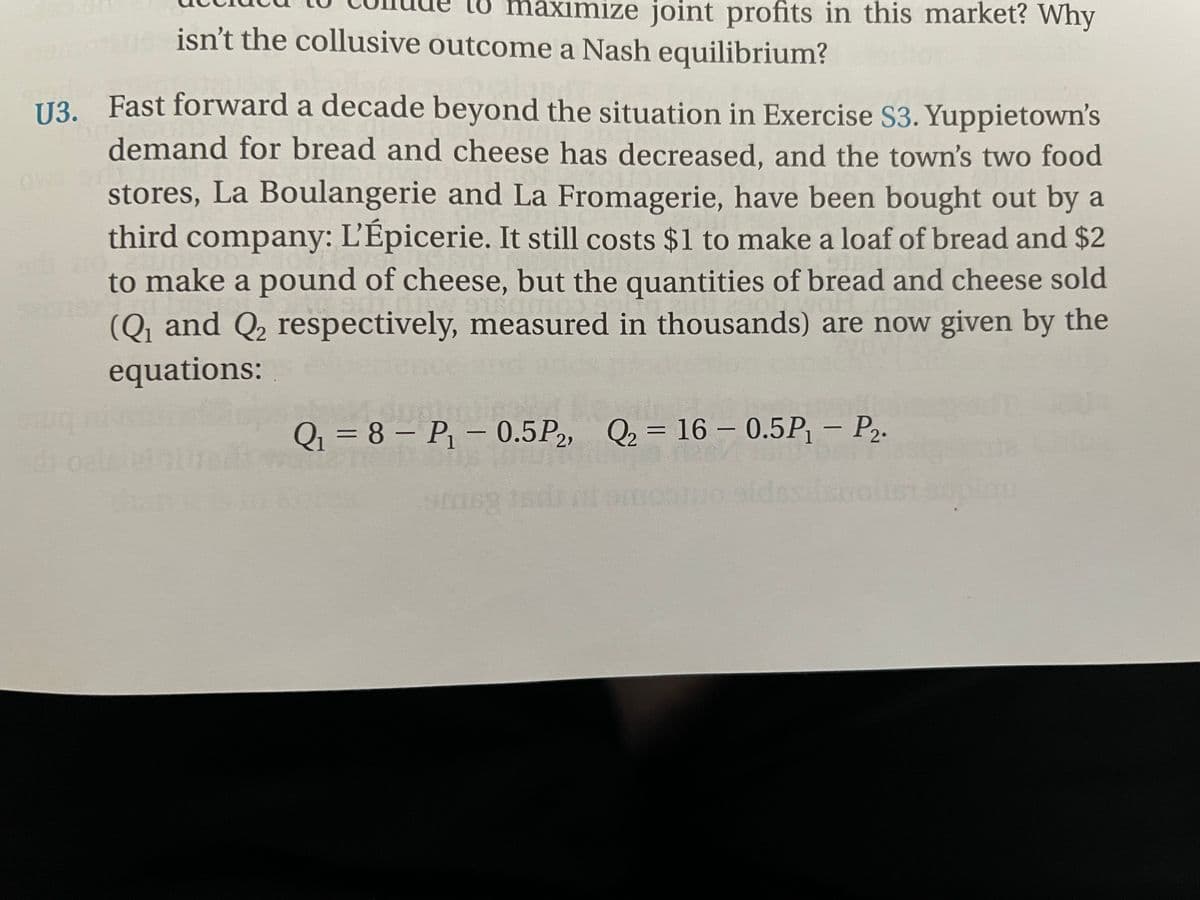U3. Fast forward a decade beyond the situation in Exercise S3. Yuppietown's demand for bread and cheese has decreased, and the town's two food stores, La Boulangerie and La Fromagerie, have been bought out by a third company: L'Épicerie. It still costs $1 to make a loaf of bread and $2 to make a pound of cheese, but the quantities of bread and cheese sold (Q and Q2 respectively, measured in thousands) are now given by the equations: Qi = 8 – P1 – 0.5P2, Q2 = 16 – 0.5P; – P2.
U3. Fast forward a decade beyond the situation in Exercise S3. Yuppietown's demand for bread and cheese has decreased, and the town's two food stores, La Boulangerie and La Fromagerie, have been bought out by a third company: L'Épicerie. It still costs $1 to make a loaf of bread and $2 to make a pound of cheese, but the quantities of bread and cheese sold (Q and Q2 respectively, measured in thousands) are now given by the equations: Qi = 8 – P1 – 0.5P2, Q2 = 16 – 0.5P; – P2.
Chapter11: The Firm: Production And Costs
Section: Chapter Questions
Problem 3P
Related questions
Question
![below cost? That is, explain a rationale of loss leaders, using your
U4. The coconut-milk carts from Exercise S7 set up again the next day. Nearly
172
[CH. 5] SIMULTANEOUS- MOVE GAMES
a
dollars of a pound of cheese.
(a) Initially, L'Épicerie runs La Boulangerie and La Fromagerie as if the
were separate firms, with independent managers who each try to
maximize their own profit. What are the Nash equilibrium quanti-
ties, prices, and profits for the two divisions of L'Épicerie, given the
new quantity equations?
(b) The owners of L'Épicerie think that they can make more total profit
by coordinating the pricing strategies of the two Yuppietown divi-
sions of their company. What are the joint-profit-maximizing prices
for bread and cheese under collusion? What quantities do La Bou-
langerie and La Fromagerie sell of each good, and what is the profit
that each division earns separately?
(c) In general, why might companies sell some of their goods at prices
below cost? That is, explain a rationale of loss leaders, using your
answer from part (b) as an illustration.
U4. The coconut-milk carts from Exercise S7 set up again the next day.](/v2/_next/image?url=https%3A%2F%2Fcontent.bartleby.com%2Fqna-images%2Fquestion%2Ffbe4d004-b0c7-4fb9-bd84-121b248ea820%2F9da03623-bc6c-49d2-bb08-efb5bdabbc29%2Fbb64jt2.jpeg&w=3840&q=75)
Transcribed Image Text:below cost? That is, explain a rationale of loss leaders, using your
U4. The coconut-milk carts from Exercise S7 set up again the next day. Nearly
172
[CH. 5] SIMULTANEOUS- MOVE GAMES
a
dollars of a pound of cheese.
(a) Initially, L'Épicerie runs La Boulangerie and La Fromagerie as if the
were separate firms, with independent managers who each try to
maximize their own profit. What are the Nash equilibrium quanti-
ties, prices, and profits for the two divisions of L'Épicerie, given the
new quantity equations?
(b) The owners of L'Épicerie think that they can make more total profit
by coordinating the pricing strategies of the two Yuppietown divi-
sions of their company. What are the joint-profit-maximizing prices
for bread and cheese under collusion? What quantities do La Bou-
langerie and La Fromagerie sell of each good, and what is the profit
that each division earns separately?
(c) In general, why might companies sell some of their goods at prices
below cost? That is, explain a rationale of loss leaders, using your
answer from part (b) as an illustration.
U4. The coconut-milk carts from Exercise S7 set up again the next day.

Transcribed Image Text:aximize joint profits in this market? Why
isn't the collusive outcome a Nash equilibrium?
U3. Fast forward a decade beyond the situation in Exercise S3. Yuppietown's
U3.
demand for bread and cheese has decreased, and the town's two food
ow
stores, La Boulangerie and La Fromagerie, have been bought out by a
third company: L'Épicerie. It still costs $1 to make a loaf of bread and $2
to make a pound of cheese, but the quantities of bread and cheese sold
(Q and Q, respectively, measured in thousands) are now given by the
equations:
Q = 8 – P – 0.5P2, Q2 = 16 – 0.5P, – P2.
Expert Solution
This question has been solved!
Explore an expertly crafted, step-by-step solution for a thorough understanding of key concepts.
This is a popular solution!
Trending now
This is a popular solution!
Step by step
Solved in 2 steps

Knowledge Booster
Learn more about
Need a deep-dive on the concept behind this application? Look no further. Learn more about this topic, economics and related others by exploring similar questions and additional content below.Recommended textbooks for you

Exploring Economics
Economics
ISBN:
9781544336329
Author:
Robert L. Sexton
Publisher:
SAGE Publications, Inc

Managerial Economics: A Problem Solving Approach
Economics
ISBN:
9781337106665
Author:
Luke M. Froeb, Brian T. McCann, Michael R. Ward, Mike Shor
Publisher:
Cengage Learning

Principles of Economics 2e
Economics
ISBN:
9781947172364
Author:
Steven A. Greenlaw; David Shapiro
Publisher:
OpenStax

Exploring Economics
Economics
ISBN:
9781544336329
Author:
Robert L. Sexton
Publisher:
SAGE Publications, Inc

Managerial Economics: A Problem Solving Approach
Economics
ISBN:
9781337106665
Author:
Luke M. Froeb, Brian T. McCann, Michael R. Ward, Mike Shor
Publisher:
Cengage Learning

Principles of Economics 2e
Economics
ISBN:
9781947172364
Author:
Steven A. Greenlaw; David Shapiro
Publisher:
OpenStax